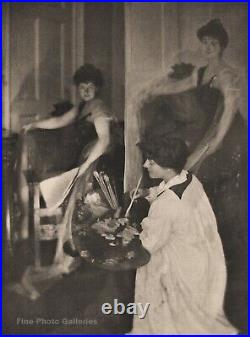

1924 Original Woman Portrait Painter EDITH WILSON New York Art Collotype Photo. Since 1989 – The Name You Can Trust For Fine Vintage Photogravures, Photographs & Antique Prints. Serving the Design & Decor trades for over 20 years. See our vintage and original prints featured in. Coastal Living, Dwell Magazine. And other fine quality publications. WE LIST DOZENS OF NEW ARRIVALS EVERY DAY! Where you can search our World Class Selection of authentic vintage prints by photographer or subject. Browse over TWELVE THOUSAND fine vintage photography prints from silver gelatin to photogravure. This Original Vintage 1926 Collotype Print Comes Professionally Dry Mounted On 11 x 14 inch Archival Presentation Mat Board And Is Ready To Place In A Standard Size Frame. The watermark name “Fine Photo Galleries” does not appear on the actual print. Wilson – Mount Vernon, New York photographer. “The Portrait Painter” Subject: Portrait of woman painting a portrait. Date Of Negative: Circa early 1920’s Type Of Print: Original Vintage Collotype Print. Date Of Print: 1926. Paper: Albion Art Paper – medium weight, matte finish. Approximate Image Size: 8 x 6 inches. 14 x 11 inches. Print Border: No – full bleed print Condition Grade: Extra Fine + + Verso: Professionally dry mounted with Bienfang archi val materials onto 4ply conservation mat board. Registered Vintage Print Serial #. C ertificate Of Authenticity (COA): Yes – Gallery Certified COA from Fine Photo Galleries. Yes – tamper proof hologram certification affixed to print mount verso and COA. Is pleased to offer. An original vintage (NOT a computer scanned reprint) 1926 Collotype print (also known as Photocollography). Whether you collect antique prints or are simply looking for extraordinary home or business decor, this atmospheric original collotype print will frame and display beautifully! This collotype print is guaranteed to be authentic and comes with a hand signed. CERTIFICATE OF AUTHENTICITY (COA) with unique individual registered serial number from the Finephoto Archive & Database. READY FOR FRAMING & DISPLAY! – The expensive photocollographic process and the resulting fine prints make vintage collotype prints highly collectible and excellent vintage prints for framing. Your vintage print will arrive ready to be placed directly into a standard size frame. While most of our clients frame our quality mounted vintage prints right out of the box exactly as delivered, you also have the option of adding an overlay window mat in the color or style of your choice which can be inexpensively done with a quick visit to your local arts/crafts store or framing shop. Each vintage artwork comes with a fully authenticated gallery certified Certificate Of Authenticity. This COA contains a unique serial number and small corresponding tamper proof hologram with matching serial number affixed to the backside of the print with archival adhesive. Our exclusive authentication system and the ensuing COA/Hologram not only provides our clients with essential peace of mind but, adds value to the print in the future by providing provenance and the original gallery authenticity guarantee documents. ABOUT VINTAGE COLLOTYPE PRINTS. Collotype printing (also called Photocollography) is a 19th century printing process that is considered one of the finest techniques for producing fine art images. It gives accurate reproduction because no halftone screen is employed to break the images into dots. In the process, a plate aluminum, glass, cellophane, etc. Is coated with a light-sensitive gelatin solution and exposed to light through a photographic negative. A collotype print is similar to a stone lithograph in many aspects. When properly executed collotype printing is capable of yielding prints which are difficult to distinguish from metal based photographic prints because of the microscopically fine reticulations which compose the image. It’s possibilities for fine art photographs were first employed in the United States by Alfred Stieglitz. Other non photographic artists used the process to produce “original” prints, most notably Marcel Duchamp and Max Ernst amongst others. Despite its unique and fine image fidelity, the labor intensive process and ensuing expense of the process caused it to give way in the latter half of the twentieth century to lower quality printing methods which were significantly less expensive. Unauthorized copying or use of ANY PART of this description is prohibited. DO NOT DUPLICATE OR COPY!
